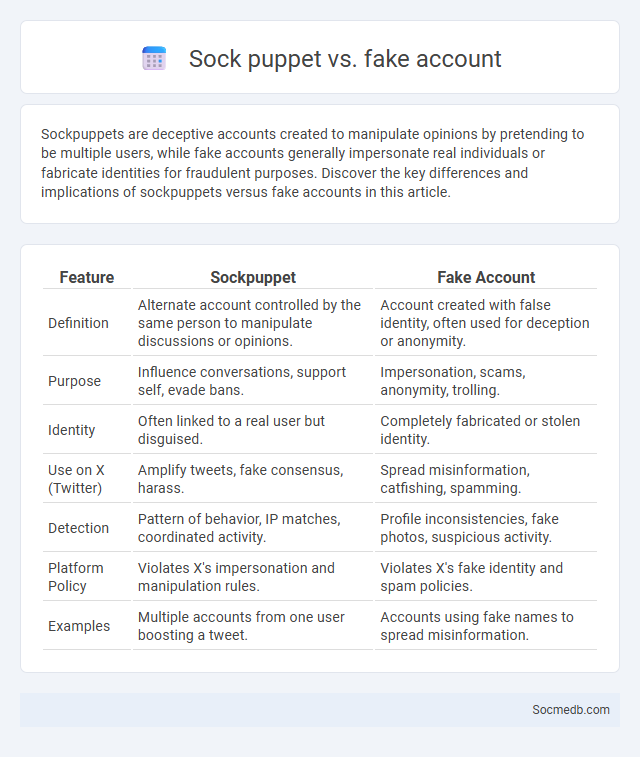
Photo illustration: Sockpuppet vs Fake Account
Sockpuppets are deceptive accounts created to manipulate opinions by pretending to be multiple users, while fake accounts generally impersonate real individuals or fabricate identities for fraudulent purposes. Discover the key differences and implications of sockpuppets versus fake accounts in this article.
Table of Comparison
| Feature | Sockpuppet | Fake Account |
|---|---|---|
| Definition | Alternate account controlled by the same person to manipulate discussions or opinions. | Account created with false identity, often used for deception or anonymity. |
| Purpose | Influence conversations, support self, evade bans. | Impersonation, scams, anonymity, trolling. |
| Identity | Often linked to a real user but disguised. | Completely fabricated or stolen identity. |
| Use on X (Twitter) | Amplify tweets, fake consensus, harass. | Spread misinformation, catfishing, spamming. |
| Detection | Pattern of behavior, IP matches, coordinated activity. | Profile inconsistencies, fake photos, suspicious activity. |
| Platform Policy | Violates X's impersonation and manipulation rules. | Violates X's fake identity and spam policies. |
| Examples | Multiple accounts from one user boosting a tweet. | Accounts using fake names to spread misinformation. |
Understanding Sockpuppets: Definition and Origins
Sockpuppets are fake online identities created to manipulate social media conversations, amplify certain opinions, or deceive users. Originating from the term for a hand puppet, these accounts were first identified in online forums and blogs, where individuals sought to fabricate support or criticism under different personas. Understanding sockpuppets helps you recognize coordinated misinformation and maintain authentic interactions on social media platforms.
What is a Fake Account? Key Characteristics
A fake account on social media is a profile created with false information or stolen identities designed to deceive or manipulate users. Key characteristics include the use of generic or stolen profile photos, unusually low engagement, inconsistent or minimal personal details, and suspicious activity such as mass following, spamming, or automated posts. These accounts often aim to spread misinformation, conduct scams, or inflate popularity metrics.
Sockpuppet vs Fake Account: Core Differences
Sockpuppet accounts are created to deceive by impersonating multiple identities controlled by the same user, often to manipulate online discussions or inflate support. Fake accounts are broadly fabricated profiles that may not aim to deceive users directly but can spread misinformation or spam. The core difference lies in sockpuppets' strategic coordination for influence versus fake accounts' general purpose of anonymity or misrepresentation.
Common Motives Behind Creating Sockpuppets
Common motives behind creating sockpuppets on social media include manipulating public opinion by generating false support or dissent, evading bans or restrictions, and promoting personal or commercial agendas covertly. These fake accounts often aim to amplify specific messages, distort conversations, or engage in deceptive marketing tactics. Understanding these motives aids in developing better detection and prevention strategies against social media misinformation and fraud.
Tactics Used by Fake Accounts in Social Platforms
Fake accounts on social media platforms employ tactics such as creating fake profiles with stolen images and fabricated backgrounds to appear legitimate. They often engage in coordinated behavior, including mass liking, commenting, and sharing to manipulate trends and boost misleading content. These accounts utilize automation tools and bots to amplify disinformation campaigns or phishing attempts, targeting vulnerable users for malicious purposes.
Detecting Sockpuppets: Signs and Red Flags
Detecting sockpuppets on social media involves identifying multiple accounts controlled by the same individual to manipulate discussions or inflate support. Common signs include similarities in writing style, posting patterns occurring simultaneously, and recurring IP addresses or device fingerprints linking accounts. Red flags also consist of coordinated messaging, creating artificial consensus, and rapid account creation with minimal personal information.
The Impact of Fake Accounts on Online Communities
Fake accounts undermine the trust and authenticity of online communities by spreading misinformation and enabling malicious behavior such as trolling and harassment. These deceptive profiles skew user engagement metrics, leading to distorted social media analytics that affect your content reach and advertising strategies. Combating fake accounts requires robust verification processes and AI-driven detection tools to preserve the integrity and safety of digital interactions.
Legal and Ethical Implications of Sockpuppetry
Sockpuppetry on social media involves creating fake accounts to manipulate public opinion, raising significant legal issues such as fraud, defamation, and identity theft. Ethically, it undermines trust, distorts genuine discourse, and violates platform policies that prohibit deceptive practices. Legal actions increasingly target sockpuppetry to protect users from misinformation and maintain transparency in digital communications.
Combating Sockpuppets and Fake Accounts: Best Practices
Combating sockpuppets and fake accounts on social media requires robust identity verification methods and AI-driven detection algorithms that analyze behavioral patterns and IP addresses. Your platform should implement multi-factor authentication and continuous monitoring to identify suspicious activities, ensuring genuine user interactions. Educating your community and enforcing strict account creation policies effectively reduce the influence of fraudulent profiles.
Future Trends in Online Identity Deception
Future trends in online identity deception will heavily leverage artificial intelligence and deepfake technology, making it increasingly difficult to distinguish between genuine and fake profiles. Social media platforms are expected to implement advanced biometric authentication and behavioral analytics to protect Your digital identity from sophisticated fraud schemes. Enhanced regulatory measures and cross-platform verification protocols will also play a critical role in combating identity theft and maintaining online trust.
 socmedb.com
socmedb.com